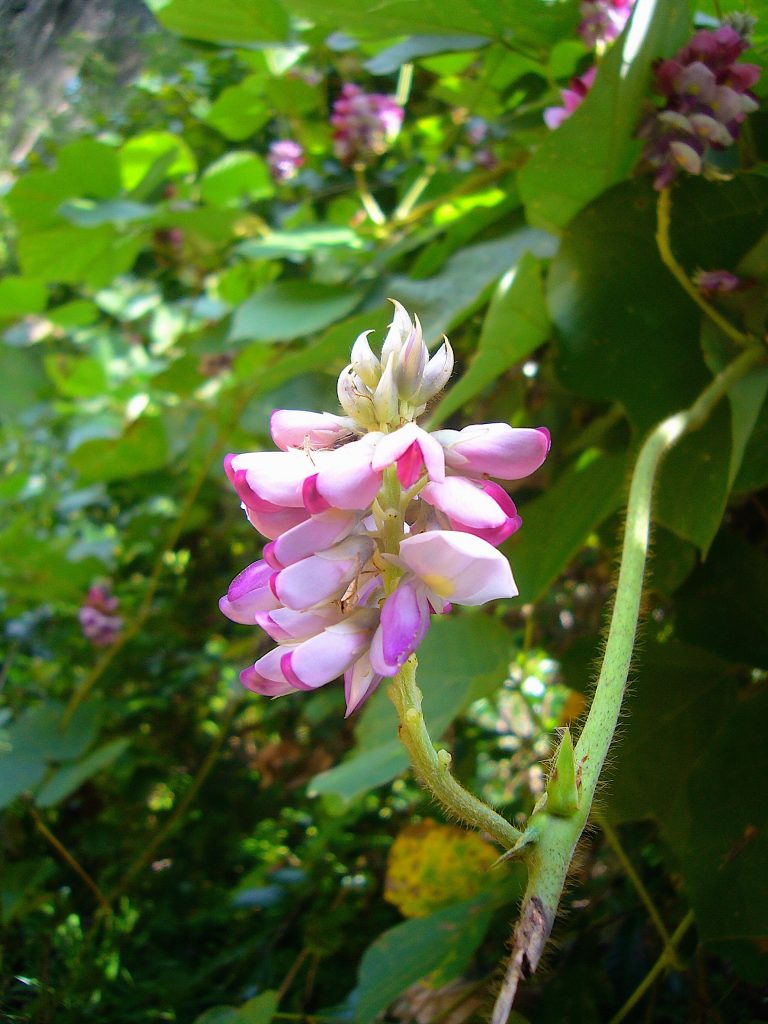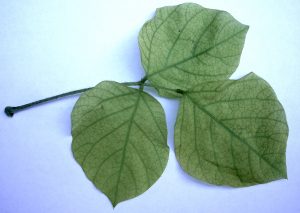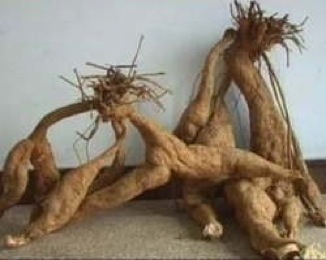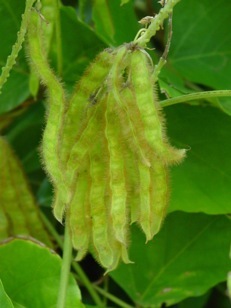
Kudzu, Pueraria montana var. lobata, the vine people love to hate. Photo by Green Deane
The state government tells me that the plant growing at the end of my street isn’t there.
It’s kudzu, the plant that grows so fast it can follow you like a puppy. It’s not a mile from here. And about eight miles further north I was collecting it some 20 years ago. Yet the government says it is not in this county. It also makes me wonder how the federal Department of Agriculture gets by. I read the USDA plant distribution maps with a skeptical eye. I’m not sure they are updated every century. And if you write to them and tell them their map is wrong… they get very attitudinal. Kudzu, Ear Tree, Wild Pineapple… NONE of them grow here officially. The only thing worst than academic botanists who never get into the field is USDA agents who can’t tell a plum from a cherry.

Kudzu leaves have hair on the edges. Photo by Green Deane
Rant over, Kudzu, Pueraria montana var. lobata, (pew-er-RAY-ree-u MON-tah-nuh var. low-BAH-tuh) is an extremely versatile plant. We just don’t use it enough. But know this: If Kudzu grows near you, you won’t starve. Indeed, economic times may make Kudzu valuable again. It’s not on menus yet but you may wish it were. A couple of years ago there’s was a Kudzu methanol car-fuel plant in the works in the U.S. but the plans stalled. The only thing about Kudzu I don’t like is the smell of the flowers in bloom: It smells exactly like the very cheap, very intense grape-flavored chemical gum kids chew. You can detect it from hundreds of feet away. Very strong, but good for identifying. If you like that aroma let your nose guide you. (I like the smell of grape, it’s that cheap artificial grape smell I can’t stand. That’s what Kudzu smells like. Kudzu has no choice, so I don’t blame it. But the gum makers do have a choice and they make the wrong one. )
Kudzu was introduced into the United State in 1876 at the Centennial Exposition in Philadelphia, Pennsylvania. The exposition was to celebrate 100 years of the United States being an independent country. Japan built a garden using Kudzu. Then it was at an exposition in New Orleans in 1883. American gardeners fell in love. By 1908 Kudzu was being promoted as a forage crop in Florida then it was widely distributed in the 1920s by a Florida nursery. (At one time they proudly displayed a ground zero Kudzu plaque.) It was planted by the conservation corps during the Great Depression and Dust Bowl Era of the 1930s and in the 1940s the government was paying farmers $8 an acre to let it grow for soil conservation. (In 2008 dollars that is $134 an acre.) It was called “the miracle vine” and cotton was no longer king of the south.
But, by 1953 even federal employees suspected something was wrong. The government stopped paying to plant it. Kudzu can grow a foot a day and when escaped from cultivation, it can smother and kill an entire forest. By 1970 the government called it a weed and it’s been a “pest” ever since finally getting on the Federal Noxious Weed List in 1997, some 44 years after the alarm was raise. A half a billion dollars is spent annually trying to contain it. Granted Kudzu is a problem, but “pest” or “resource” is a matter of attitude and policy. It’s a huge amount of food not being consumed, a resource not being used. What would a country in famine do with those hundreds of thousands of acres of food? I doubt they would call it a noxious weed. Perhaps instead of sending dollars to the starving we should send them nutritious kudzu.
Kudzu can be eaten many ways. The young leaves can be consumed as a green, or juiced. They can be dried and made into a tea. Shoots can be eaten like asparagus. The blossom can be used to make pickles or a jelly — a taste between apple and peach — and the root is full of edible starch. Older leaves can be fried like potato chips, or used to wrap food for storage or cooking. With kudzu you can make a salad, stew the roots, batter-fry the flowers or pickled them or make a make syrup. Raw roots can be cooked in a fire, roots stripped of their outer bark can be roasted in an oven like any root vegetable; or grated and ground into a flour to make a thickener, a cream or tofu. Kudzu is used to make soaps, lotions, rope, twine, baskets, wall paper, paper, fuel and compost. It can also be baled like hay with most grazing animals liking it, especially goats. Only the seeds are not edible. And while the root starch is edible, it takes hours of pounding to get the starch out, as my friend Doug Elliott wrote in his book, Roots.
Kudzu, to someone not familiar with it, does have a couple of look-alikes, such as the Desmodium rotundifolium, or the Ticktrefoil. Kudzu has very hairy young stems, the D. rotundifolium does not… that and that Kudzu goes wild and outgrows it. The hog peanut, Amphicarpaea bracteata, may be mistaken for young Kudzu vines, but it does not have hairy stems or climbs into trees. The key is to look for hairy stems on the young Kudzu, and when it blossoms follow the grape aroma.
The word “kudzu” comes from the Japanese word “kuzu” which means vine. The name itself comes from a particular region of Japan where the people are also called Kuzu. It is not known which came first, the name or the people. Pueraria was named after the Swiss botanist Marc Nicolas Puerari who taught in Copenhagen. Montana means mountainous. Lobata means lobes. Sometimes the plant is called Pueraria lobata, skipping the Montana part. In China it is called gé gēn.
Kudzu is not a famine food but prime fare. We call it a weed because we are not hungry enough… yet. Recipies on bottom. By the way goats love Kudzu and it is by far not the most invasive species in the South. The Asian Privet is.
Green Deane’s “Itemized” Plant Profile
IDENTIFICATION: Kudzu is a climbing, semi-woody, vine that can reach up to 100 feet in length. Stems can reach the diameter of ½ to 4 inches, old ‘stumps’ can be nearly 12 inches across. Leaves alternate, compound with three broad leaflets to 4 inches across. Leaflets may be entire or deeply 2-3 lobed hairy underneath. Flowers are ½ inch long, purple, highly fragrant in long clusters. Flowers in late summer, seeds pods brown, hairy, flattened, containing three to ten seeds.
TIME OF YEAR: Shoots in spring, young leaves anytime, blossoms July through October, roots best in fall or early spring.
ENVIRONMENT: Likes full sun, heat, plenty of water.
METHOD OF PREPARATION: Nearly too numerous to mention. Most of the plant is edible in some way except the seeds and seed pods. They are not edible.
Herb Blurb
In the Orient, it is used to treat dysentery, allergies, migraine headaches, diarrhea, fevers, colds, intestinal problems and angina pectoris, to help with the digestion of food and reduce blood pressure. Kudzu has been used successfully for centuries as a treatment for alcoholism, and this is a main focus of modern kudzu medical research today. Experiments with hamsters and rats, show that a compound in kudzu actually causes the repression of alcohol consumption. This research could have great value in the future for the treatment of alcoholism
Kudzu Blossom Jelly
Spoon over cream cheese, or melt and serve over waffles and ice cream. The blossom liquid is gray until lemon juice is added.
4 cups Kudzu blossoms
4 cups boiling water
1 tablespoon lemon juice
1 (1 3/4-ounce) package powered pectin
5 cups sugar
Wash Kudzu blossoms with cold water, and place them in a large bowl. Pour 4 cups boiling water over blossoms, and refrigerate 8 hours or overnight. Pour blossoms and liquid through a colander into a Dutch oven, discarding blossoms. Add lemon juice and pectin; bring to a full rolling boil over high heat, stirring constantly.
Stir in sugar; return to a full rolling boil, and boil, stirring constantly, 1 minute. Remove from heat; skim off foam with a spoon. Quickly pour jelly into hot, sterilized jars, filling to 1/4 inch from top. Wipe jar rims. Cover at once with metal lids, and screw on bands.
Process in boiling water bath 5 minutes. Cool on wire racks. YIELD: 6 half pints.
Rolled Kudzu Leaves
Kudzu Leaves
1 can diced tomatoes
2 teaspoons salt
3 cloves garlic, cut in half
Juice of 3 lemons
Bacon Grease (optional)
Stuffing ingredients: 1 cup rice, rinsed in water
1 pound ground lamb or lean beef
1 cup canned diced tomatoes
1/2 teaspoon of allspice
Salt and Pepper to taste
Gather about 30 medium-sized young kudzu leaves. Make sure area has not been sprayed with chemicals.
Wash leaves. Drop into salted boiling water. Boil a 2-3 minutes, separating leaves. Remove to a plate to cool. Remove heavy center stems from the leaves by using a knife and cutting down each side of the stem to about the middle of the leaf. Combine all stuffing ingredients and mix well.
Push cut sides together and fill with 1 teaspoon stuffing and roll in the shape of a cigar. Place something in bottom of a large pan so that rolled leaves will not sit directly on the bottom of the pan. Bacon grease is great for seasoning.
Arrange Kudzu rolls alternately in opposite directions. When all are in the pot, pour in a can diced tomatoes, 2 teaspoons of salt, and 3 cloves of garlic, cut in half. Press down with an inverted dish and add water to reach dish. Cover pot and cook on medium for 30 minutes. Add lemon juice and cook 10 minutes more.
Kudzu Quiche
Makes 4-6 servings.
1 cup heavy cream
3 eggs, beaten
1 cup chopped, young, tender Kudzu leaves and stems
1/2 teaspoon salt
Ground pepper to taste
1 cup grated mozzarella cheese
1 nine-inch unbaked pie shell
Preheat oven to 350 degrees. Mix cream, eggs, kudzu, salt, pepper, and cheese. Place in pie shell. Bake for 35 to 45 minutes until center is set.
Kudzu Tea
Kudzu leaves
Mint
Honey
Simmer 1 cup of finely chopped Kudzu leaves in a quart of water for 30 minutes. Drain and serve with honey and a sprig of mint. If you prefer a sweeter taste use honey to sweeten the tea.
Deep Fried Kudzu Leaves
Pick light green leaves, 2-inch size.
Thin batter made with iced water and flour
Oil
Heat oil. Rinse and dry kudzu leaves, then dip in batter (chilled). Fry oil quickly on both sides until brown. Drain on paper toweling. Eat while warm.
kudzu powder
Kudzu powder can be prepared on a small scale from wild kudzu with little equipment. Roots no smaller than 1 1/2” in diameter should be harvested during the winter months, December through March. Kudzu root should be washed, cut into approximate one-inch thick slices and pureed in a blender with enough cold water to blend the root well. The puree should be strained and the solid fibers squeezed to extract all the liquid to be used for further processing. The remaining fibers should then be saturated with water, stirred, and strained again, collecting the liquid into the container with the other extract. The brown kudzu liquid should be filtered through muslin or lower grade cotton fabric and left undisturbed in a cool or cold location for 24 hours. The fibers can be composted and the brown liquid should then be discarded as grey water. The clay like substance remaining in the container should be broken up and mixed well, until thoroughly dissolved with clean water once again, and allowed to rest for 24 hours in a cool environment. The liquid should again be discarded and the starch redissolved into a second batch of clean water, this time leaving the mixture for 48 hours in a cool place. The liquid should then be discarded and the layer of gray impurities removed from the starch. The starch is then ready to be used immediately or can be dried to preserve it indefinitely. To dry the kudzu starch, place kudzu chunks on a tray or on layers of paper and set it in a cool, well ventilated place for 10 to 40 days until thoroughly dry. Store dry chunks of kudzu in a sealed container. The dry chunks of kudzu, when pulverized, become kudzu powder.
Kudzu Flower Wine
4 quarts water
6 quarts fresh kudzu blossoms
yeast
4 cups sugar 1 gallon jug 1 balloon
Pick kudzu blossoms when they are dry (mid-day). Wash in pan of water containing 1/2 cup vinegar to kill any bugs. Pour 2.5 quarts of boiling water over the blossoms and stir. Put a lid on the container and stir twice a day for four days.
Strain the liquid through a clean cloth. Press the blossoms to get all the liquid from them. Add four cups sugar. Dissolve yeast in lukewarm water. Pour the dissolved yeast into the liquid. Stir well. Transfer to a one-gallon jug. Add enough water to bring the liquid within 2 inches below the neck of the jug. Attach the balloon and secure it with twine or a strong rubber band. Place jug in a cool dark place that is between 60° F to 75° F.
Every other day gently loosen the balloon and allow the gas to escape and then replace the balloon firmly on the neck of the jug. In approximately 6 weeks the balloon will stop expanding and the wine is done. Strain the wine through a clean cloth and transfer it to airtight bottles. Allow it to sit for an additional two to twelve months before drinking.
Kudzu Root Sucker
In a survival situation, any kudzu root between 1/2 to 3/4 inches in diameter can be washed, cut at both ends to a length of about 6 inches, and then all the exterior bark should be scrapped off. The raw root can then be sucked on to gradually remove all its internal nutrients. Only suck the nutrients out of the root. The root is wood. Wood is NOT digestible. Do NOT eat the wood.
Kudzu Root Tea
The thin, tender young roots can be dug up, washed, diced, boiled, and strained to make a tea.




